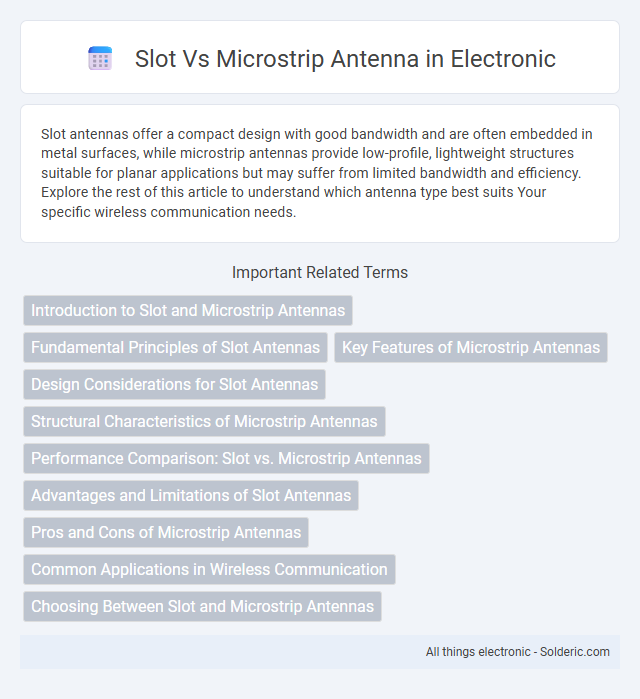Slot antennas offer a compact design with good bandwidth and are often embedded in metal surfaces, while microstrip antennas provide low-profile, lightweight structures suitable for planar applications but may suffer from limited bandwidth and efficiency. Explore the rest of this article to understand which antenna type best suits Your specific wireless communication needs.
Comparison Table
| Feature | Slot Antenna | Microstrip Antenna |
|---|---|---|
| Design | Radiating slot cut in a metal surface | Patch conductor on dielectric substrate |
| Size | Generally larger for same frequency | Compact and low profile |
| Bandwidth | Narrow to moderate bandwidth | Typically narrow bandwidth |
| Polarization | Linear, often dual-polarized | Linear or circular polarization |
| Radiation Pattern | Bidirectional, broadside to slot | Directional, broadside to patch |
| Impedance Matching | Complex, needs slot tuning | Relatively easier with feed techniques |
| Manufacturing | Requires precise slot etching | Simple PCB fabrication process |
| Applications | Radar, microwave systems | Mobile devices, GPS, WLAN |
Introduction to Slot and Microstrip Antennas
Slot and microstrip antennas are essential components in modern wireless communication systems, each characterized by distinct radiation mechanisms and structural designs. Slot antennas operate by slotting a metal surface, creating resonant apertures that efficiently radiate electromagnetic waves, while microstrip antennas consist of a conductive patch separated from a ground plane by a dielectric substrate, offering planar, low-profile configurations. Their differences in bandwidth, polarization, and fabrication ease make them suitable for various applications such as radar, satellite, and mobile communication.
Fundamental Principles of Slot Antennas
Slot antennas operate based on the principle of electromagnetic wave radiation through a narrow slot cut into a conductive surface, acting as a magnetic dipole. The slot's geometry and dimensions determine the resonant frequency, enabling efficient radiation by causing currents around the slot edges to generate the radiated fields. Unlike microstrip antennas, which utilize a patch radiator above a ground plane, slot antennas rely on the complementary structure to excite surface currents and produce a distinct radiation pattern.
Key Features of Microstrip Antennas
Microstrip antennas are characterized by their low profile, lightweight structure, and ease of fabrication on printed circuit boards, making them ideal for compact and portable wireless devices. They exhibit narrow bandwidth but can be enhanced through techniques like substrate selection and patch shape variation to improve performance. Your communication system benefits from their conformal design and compatibility with integrated circuits, enabling seamless integration in modern RF applications.
Design Considerations for Slot Antennas
Slot antenna design considerations include the slot's shape, size, and orientation, which directly influence the resonant frequency, bandwidth, and radiation pattern. The substrate material and thickness play crucial roles in impedance matching and efficiency, requiring precise control to minimize losses. Optimizing feed point location and slot geometry enhances performance parameters, making slot antennas suitable for compact and high-frequency applications compared to microstrip antennas.
Structural Characteristics of Microstrip Antennas
Microstrip antennas feature a planar structure with a radiating patch mounted on a dielectric substrate above a ground plane, enabling compact design and ease of fabrication. The patch, typically made of conductive materials like copper or gold, can be shaped as rectangles, circles, or other geometries to optimize performance at specific frequencies. Their low profile and compatibility with printed circuit technology make them ideal for integration in modern wireless communication systems.
Performance Comparison: Slot vs. Microstrip Antennas
Slot antennas exhibit higher bandwidth and better power handling capabilities compared to microstrip antennas, which are often limited by narrow bandwidth and lower efficiency. Microstrip antennas offer advantages in compact size, ease of fabrication, and integration with planar circuits but typically suffer from lower gain and radiation efficiency. Performance metrics such as return loss, radiation pattern, and impedance bandwidth consistently show slot antennas outperforming microstrip designs in high-frequency and wideband applications.
Advantages and Limitations of Slot Antennas
Slot antennas offer advantages such as low profile, ease of integration with printed circuit boards, and wide bandwidth, making them ideal for compact wireless devices. Their limitations include relatively lower gain compared to microstrip antennas and sensitivity to fabrication tolerances, which can affect performance. You can benefit from slot antennas in applications requiring conformal or concealed designs where space and stealth are critical.
Pros and Cons of Microstrip Antennas
Microstrip antennas offer advantages such as low profile, lightweight design, and ease of fabrication on printed circuit boards, making them suitable for compact and wearable devices. They provide good integration with microwave circuitry and support array configurations for beamforming but suffer from narrow bandwidth and lower gain compared to slot antennas. The limited power handling capability and sensitivity to environmental factors are notable drawbacks in high-performance or outdoor applications.
Common Applications in Wireless Communication
Slot antennas are frequently used in radar systems and satellite communications due to their robust performance in high-frequency ranges. Microstrip antennas find broad applications in mobile phones, GPS devices, and wireless LANs for their compact size and ease of integration into printed circuit boards. Your choice between these antennas depends on specific wireless communication requirements such as frequency, size constraints, and environmental conditions.
Choosing Between Slot and Microstrip Antennas
Choosing between slot and microstrip antennas depends on application-specific factors such as bandwidth, size, and polarization requirements. Slot antennas offer wider bandwidth and better power handling, making them ideal for radar and high-frequency applications, while microstrip antennas provide compact size and ease of integration suitable for mobile devices and wireless communication. Design constraints, operating frequency, and fabrication cost also play crucial roles in selecting the appropriate antenna type.
slot vs microstrip antenna Infographic

 solderic.com
solderic.com